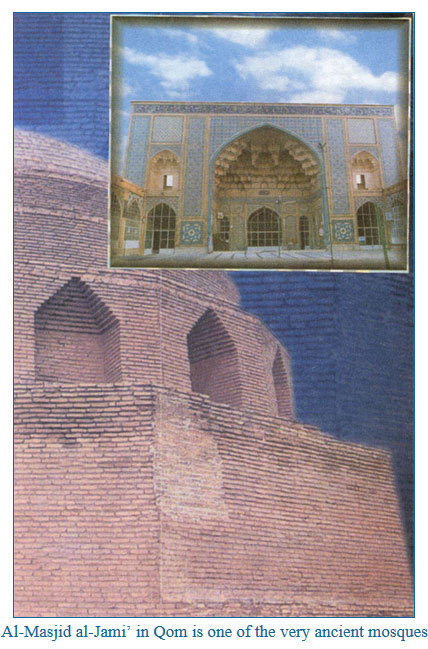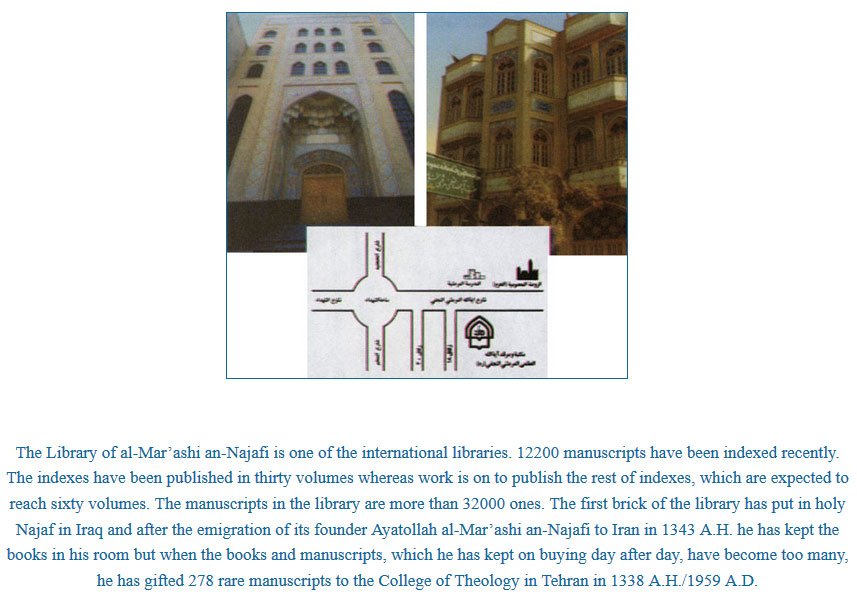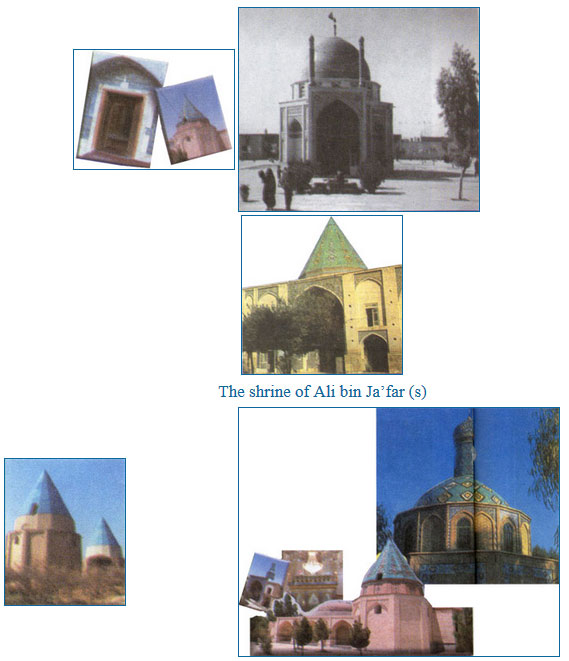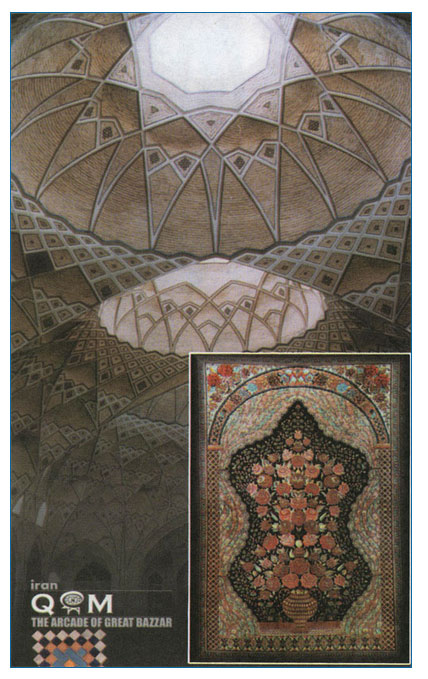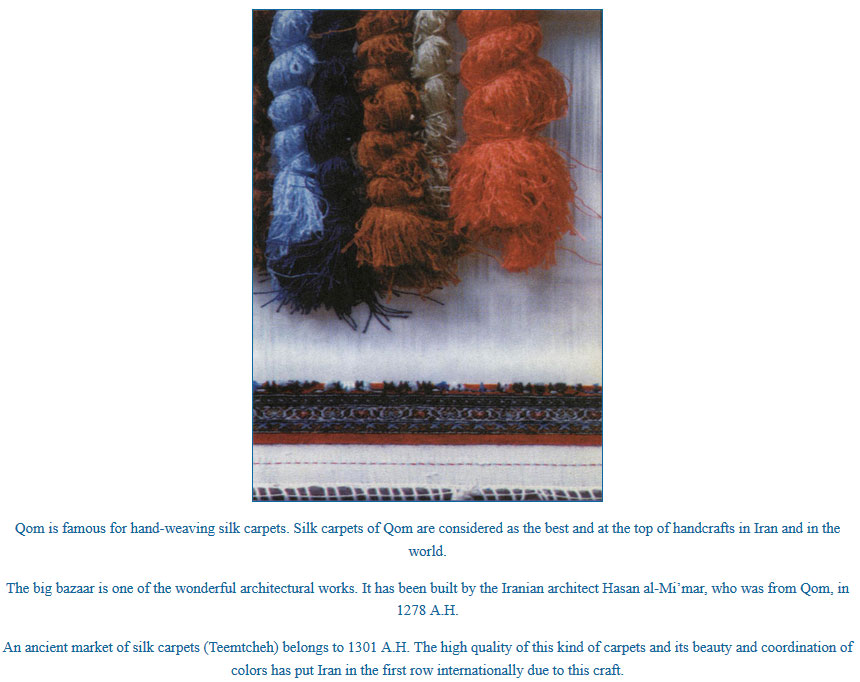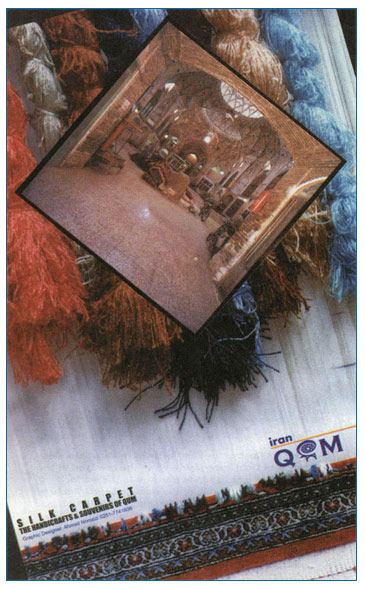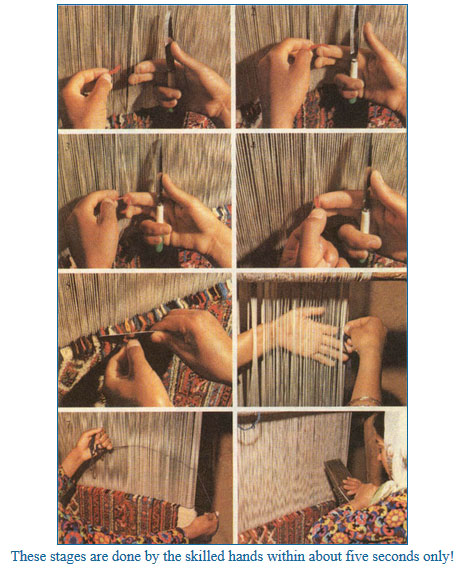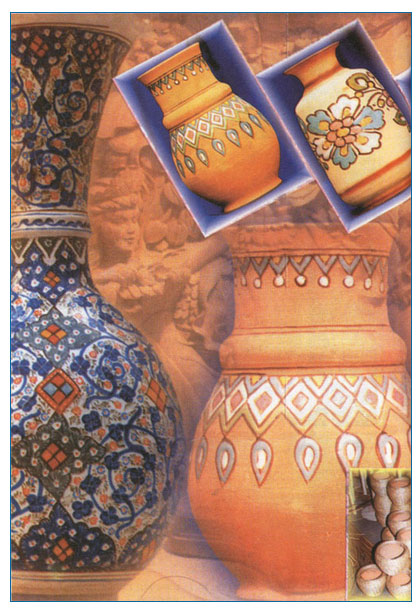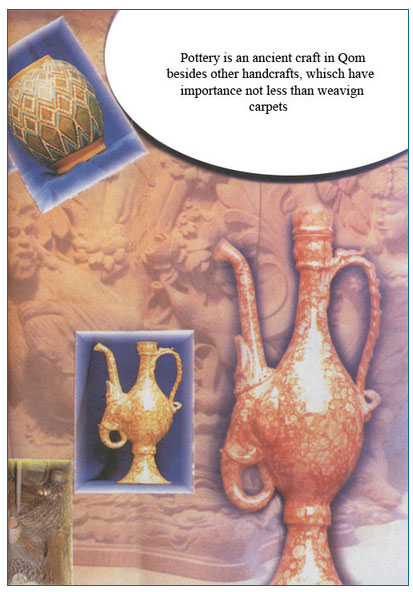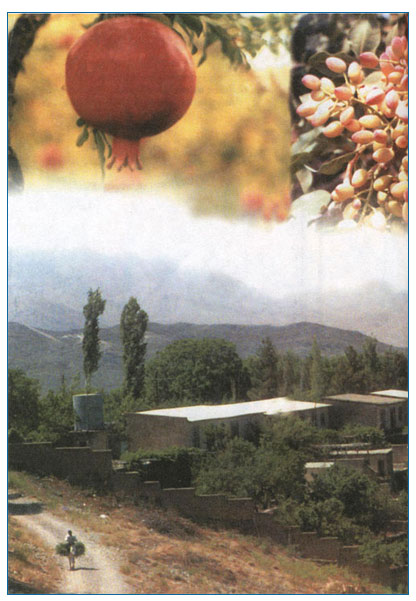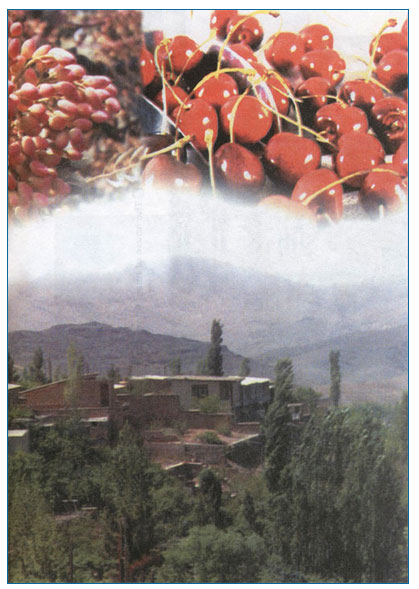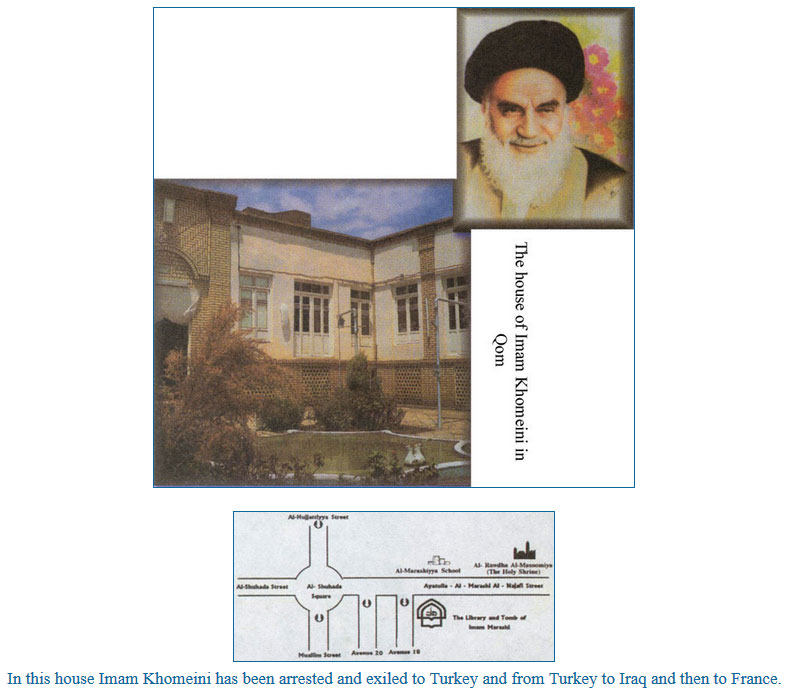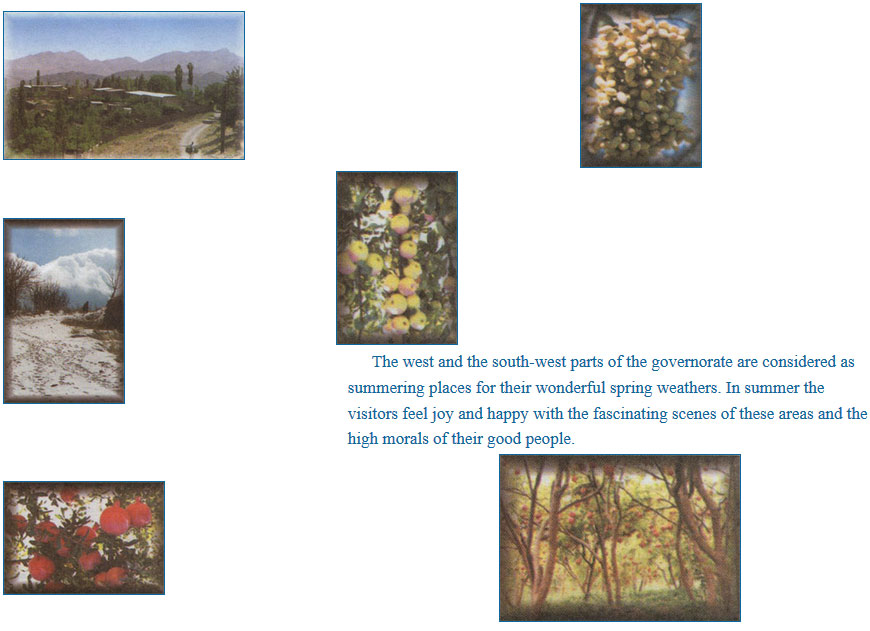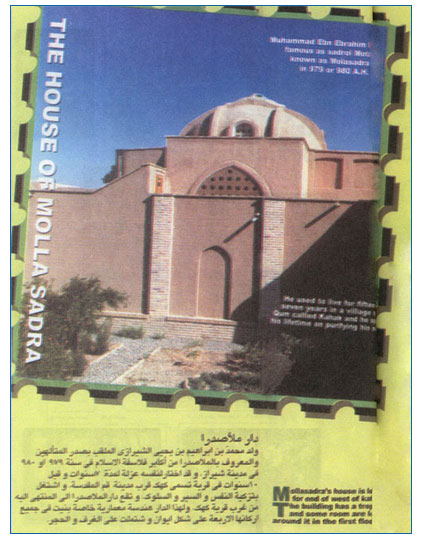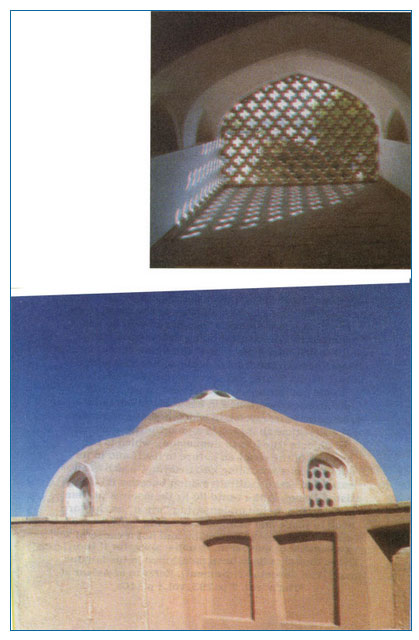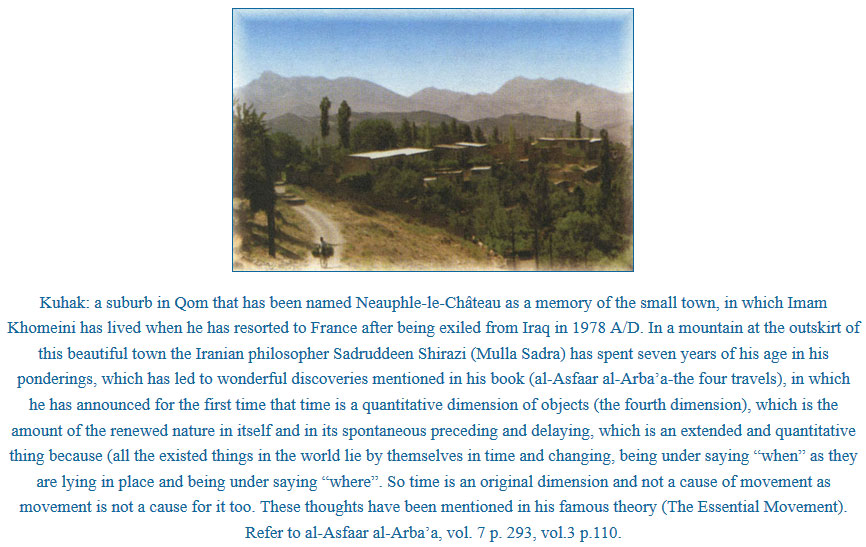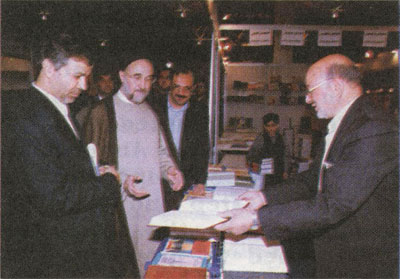QOM; GEOGRAPHICALLY AND HISTORICALLY
There is no an accurate dating about the establishment of this city nor a certain reason behind its name. There are some historians confirming that its history belongs to the pre-Islamic conquest period relying on some historical manuscripts, which show clearly that the city has been available during the age of Anushirvan, the Persian king.
It (Qom) has been mentioned during the Islamic conquests when talking about the battle of Jalawla’ against Khosrow, the last king of the Sasanian dynasty, where Hijr bin Adiy was one of the leaders of the Islamic armies at that day.
Hence the history of the city belongs to the period before the year twenty-third A.H. (the year of (al-Fat~h-the Conquest) for a long time.
Many stories have been said about the name of the city each trying to give an explanation about it. Some have said that its name was “Kumondan”
and then some of its letters have been dropped and others have said that the original name was “Kam” meaning “little” that it was a small village and then it was Arabized into “Qom” after the Islamic conquests.
But the name of the city began to shine on the Islamic map after it had been occupied by the Ash’arites
in ninety-four A.H. They had tried their best to build the city. It grew and became one of the important cities in Persia after its people had believed in Ahlul Bayt
(s) and after it had become independent of Isfahan
in 189 A.H.
The fate had willed that the city was to be one of the sacred cities after its ground had embraced the pure body of Fatima, the daughter of Imam Musa al-Kadhim
(s) in 201 A.H. Hence it could be said that since that date the city of Qom had begun to ascend the stairs of glory to be at the head of the Islamic capitals.
The city has paid the price of its allegiance and love to Ahlul Bayt (s) so expensively along all the ages. The Abbasid policy has followed a degrading means by imposing very heavy taxes.
In spite of that there was a kind of political ease towards Ahlul Bayt (s) during the reign of al-Ma’moon.
History has recorded that a revolution has broken out in Qom in 210 A.H. because of the heaviness of taxes but the revolution has been suppressed severely, the walls of the city have been destroyed and the taxes have been increased three and a half times.
Some books of history mentions stories, which are like fables, about the name of the city. One of them says that the Prophet (s), during his ascension to the Heaven, has seen a place on the earth, which was more beautiful than the color of saffron and with a fragrance better than the fragrance of musk, and has seen an old man putting a long cap on his head. The Prophet (s) asked Gabriel and Gabriel said: “This is the place of your Shia and your guardian’s Shia and this old man is Iblis. He invites people to disbelieve.” The Prophet (s) asked Gabriel to swoop down and Gabriel swooped down faster than lightening. The Prophet (s) shouted at Iblis: “Get up (qom)
O you cursed!” Then the city was called as “Qom”!
In spite of the vicissitudes of time, the city has withstood throughout the ages of history and has remained as a capital of knowledge and intellect and as a refuge for the wronged and subdued people of the Prophet’s progeny. This is why there are many shrines of the Hashemites
in this great city.
Qom in traditions
Much praise has been mentioned in traditions related to Imam as-Sadiq
(s). He said:
“Above Qom there is an angel flapping his two wings. No arrogant intends to offend it (Qom), unless Allah will make him melt away like salt being melted in water.”
He also said:
“If you are afflicted with distress and suffering, you are to resort to Qom because it is the refuge of the Fatimites
and the resort of the believers.”
Imam Musa al-Kadhim (s) said:
“Qom is the shelter of Muhammad’s progeny and the resort of their Shia.”
He also said in another tradition, which was as an astonishing prediction:
“There will be a man from Qom, who will invite people to the truth and great masses of people will join him. They will not be shaken by the most violent storms.”
This tradition has become real after the Islamic revolution under the leadership of Imam Khomeini (may Allah be pleased with him).
There is another tradition of Imam as-Sadiq (s) deserving to be pondered on. Imam as-Sadiq (s) said:
“The ground of Qom is sacred. Its people are from us and we are from them. No arrogant tries to offend them, unless his punishment will be hastened to him as long as they do not betray their brothers. If they do that, then Allah will subject them to the offenses of the arrogants.”
There is another tradition related to Imam as-Sadiq (s) talking about Fatima al-Ma’ssooma (s).
He said:
“We have a sanctum. It is the village of Qom, in which a woman from my progeny will be buried. Her name will be Fatima.”
Biography of Fatima al-Ma’ssooma
Fatima al-Ma’ssooma (s) was born in Thil Qa’da,
173 A.H. She was six years old when her father Imam al-Kadhim (s) was put in prison in 179 A.H.
She had several surnames but she was known as “al-Ma’ssooma”. It not known exactly why she has been surnamed as al-Ma’ssooma but there might be some reasons behind that.
The girl was pure and infallible besides that she was a daughter of the seventh imam of the infallible house of the Prophet (s), a sister of an infallible imam (Imam ar-Redha
(s)) and an aunt of an infallible imam (Imam al-Jawad
(s)).
We could add another reason that she had died oppressedly far from her nation while she was still a famous than her name.
In 201 A.H. Fatima al-Ma’ssooma
(s) decided, with some of her brothers, to travel to Marw,
which was then the capital of the Islamic state after the end of the war between the two Abbasid brothers, al-Ameen and al-Ma’moon, who won the war and killed his brother.
Al-Ma’moon, after becoming the caliph, took a decision, whose motives have been still disputable until now, to make, apparently, reconciliation between the Alawite
house and the Abbasid house and to put an end to the distresses of Ahlul Bayt (s). Many people doubted the intents of al-Ma’moon when he appointed Imam ar-Redha (s) as his crown prince. They had convincing justifications about doubting the real intents and aims of al-Ma’moon towards the progeny of Ali (s).
It was very probable that the travel of Fatima al-Ma'ssooma (s) with her brothers, which was in tow separate caravans; one followed the way of Basra to Shiraz and then to Marw and the other followed the way of Hamadan-Sawa
and then to Marw, was to confirm the situation of Imam ar-Redha (s), whom al-Ma’moon had begun to confine. What confirmed these doubts that the two caravans did not reached Marw. The first one stopped at Shiraz and its people separated here and there after a clash with government forces and the other stopped at Sawa. Some historical sources mentioned that the second caravan had been attacked too and that Fatima al-Ma'ssooma (s) felt that she was about to die after she had felt too weak and this made her ask about the city of Qom. It was said to her that Qom was about eighty kilometers and so she asked to be taken there.
Whether her sickness was because of poison, which had been inserted into her food, or because of the great tiredness and sufferings that she had faced, she died after seventeen days only after arriving at Qom. She was as a guest of Musa bin
Khazraj until she died after some days to be buried in a land called Babulan belonging to this man.
After a period of time, this land became a great graveyard containing bodies of thousands of narrators, speechers, leaders and rulers. This peace of land became the central part of the city, which began to grow rapidly.
The Holy Shrine
The shrine (of Fatima al-Ma'ssooma) was at first as a shed of straw mat erected according to the order of Musa bin Khazraj al-Ash’ari to be now as a high gold dome, around which high minarets rising towards the Heaven.
Through twelve centuries the shrine has been rebuilt many times.
The first dome, after that straw mat shed, has been built after half a century by the order of Zaynab, the daughter of Imam al-Jawad (s) in the middle of the third century of hijra. It has been built with adobe, stone and plaster.
Then two other domes have been built after some Alawite ladies have been buried (in the same shrine). The three domes remained until the middle of the fifth century of hijra when the first high dome has been built to replace those three domes. It has been built by the vizier of Tugril the Great
after encouragement by Sheikh at-Toossi. This dome has been decorated with colored figures, bricks and tiles (kashi).
In 925 A.H. the roof of the dome has been decorated with mosaic according to the order of Lady Beigam, the daughter of Shah Issma’eel as-Safawi (the Safavid). Also a hall and two minarets have been built in the old yard.
Finally, Fathali (Fat~h Ali) Shah al-Qajari
has ordered to decorate the roof of the dome with gold plates to remain shining for two centuries.
After some damage had happen to some of the gold plates, the office of the custodian of the shrine decided to rebuild the dome. The old gold plates have been collected to be replaced with others in a great project,
whose cost might be twenty-five milliard Iranian rials (one dollar equals eight thousand rials).
In general the shrine is a structure with wonderful signs of Islamic architecture. It has been adorned with marvelous figures.
The total area of the shrine is about fourteen thousand square meters including the haram, the porches, the halls, the three yards,
the tombs of the kings and the two mosques; at-Tabataba’iy and Balasar (over the head). Lately the Great Mosque has been added to the shrine. The area of the Great Mosque alone is about twenty-five thousand square meters.
When a visitor arrives at the outskirts of the city, he will see two minarets shining distantly.
The dome leans over a silver tomb crowned with gold. The tomb is four meters high, five meters and twenty-five centimeters long and four meters and seventy-three centimeters wide.
The northern hall is fourteen meters and eighty centimeters high, eight meters and seventy centimeters wide and nine meters long. It is adorned with gold from inside and its figures are demarcated with gold too. Upon this hall the two minarets go high in the space until thirty-two meters and twenty centimeters from the ground. The diameter of each minaret is one hundred and fifty centimeters. This hall is called “the hall of gold” and its gate is called “the gate of gold”.
In the eastern side there is a hall decorated with hundreds of mirrors where lights reflect to make it more beautiful and wonderful. This hall adjoins with the haram by a porch, which is seven meters and eighty centimeters high, seven meters and eighty-seven centimeters wide and nine meters long. The porch stands on four stone pillars. Each of them is eleven meters high.
There are two minarets on this hall. Each of them is twenty-eight meters high from the roof of the hall. It is written on the top of them in one meter width “la hawla wela quwatta illa billah: there is no power save in Allah” and on the other one “subhanallah, wel hamdu lillah, wela ilaha illallah, wellahu akbar: glory be to Allah, praise be to Allah, there is no god but Allah and Allah is Great”.
The visitors feel a state of spirituality and happiness under the shadows of the shrine and in the new yard where several minarets extend high towards the Heaven and lights reflect in the hall, which is decorated with hundreds of mirrors besides the flying flocks of doves, which have taken this holy shrine as warm nests while the fountains dance in a glittering pool.
In the past the visitors and tourists could come into a museum from the yard of the shrine directly but now this way is closed and the museum has a gate outside the shrine in the Moozeh (museum) street.
The museum, which consists of two floors, contains a good group of gifts and valuable things that have been gifted to the holy shrine throughout its long history.
Surely whoever visits the museum feels eager to see al-Faydiyya school beside it, which is one of the most famous religious schools and hawzas.
This school, according to certified facts, has replaced al-Aastana school. It is connected with the haram by a hall in the old yard.
A tourist’s attention may be drawn by the masses of the passer-bys between the small park adjacent to the street and between the school, the museum and the markets. He may think to take his way to the bazaar!
A tourist will feel that he enters a museum showing him different kinds of arts of architecture and different handworked goods in this ancient bazaar.
A tourist may ask, in the other side of the bazaar, about “Baytun noor: the house of light”, which is one of the important marks in the city that has become a school called as-Satiyya, where Fatima al-Ma'ssooma (s) had lived as a guest for seventeen days before she left to the better world.
Qom; Country and People
Qom is the smallest governorate in Iran. Previously it was as a district belonging to the governorate of Arak and then it was attached to Tehran until it was certificated to be as independent governorate.
Its population was not more than one hundred and fifty thousand in 1957 A.D. In 1979, when the Islamic revolution triumphed, the population of the city was about three hundred thousand.
The city has progressed so much and has gotten much attention from the government after the years of deliberate neglect during the reign of Shah. After the triumph of the Islamic revolution, the city began to grow rapidly until its population became more than one million besides the many foreign students coming from the different continents of the world. They have come to study in Qom and then they got married and make families or they have brought their families with them. There are also many Afghan emigrants, who are more than half a million besides some thousands of Iraqi emigrants.
The city has flourished and prospered in every side especially that there is cheap employment because of the great numbers of the emigrant Afghans.
The cultural life has become too prosperous because of the availability of learned Arabs, among whom the Iraqis form a great proportion.
As for the texture of the local population of the governorate, we can say that only nine percent live in the countryside whereas ninety percent live in the city.
Nearly half a century ago the farms and gardens covered most parts of Qom and then they began to abate little by little before the expansion of building.
Some people, who have lived in the city about fifty years ago or those who have been born in the city, refer to some main streets of the city and say that they were as gardens full of pomegranate and fig trees.
Some famous quarters in the city are still having names that refer to their rural origins.
Nevertheless Qom was and is still as a district having a desert and semi-desert climate.
There are some certain areas having cold mountainous climate and others having moderate climate but the general climate of this governorate is the semi-desert climate.
At the shores of the “Lake of Salt” there is a long line of desert having many dunes. After that and towards the north and the west-north there are wide wild lands, in the western side of which Qom is. As for the moderate areas, they form the western line and have an area four times more than the area of the desert line. There is a small area having a cold mountainous climate around Mountain Ghaleek, which is 3171 meters high.
The western line has an important role in the life of the governorate because it has fertile agricultural lands and many water sources.
From among fourteen rivers flowing in the land of the governorate there are only two permanent rivers; one is “Qara Chai”, which flows from the mountains of “Shazand” in Arak to the west of Qom and the other is “Qamrood”, which flows from the mountains of “Khawansar” in the south.
The rate of raining in the governorate is about 138 millimeter. It is very little rate in comparison with the general rate of rain in Iran, which is about 255 millimeter.
Once Sayyid Muhsin al-Ameen al-Aamily has passed by this city and written down his notes about it in his Iraqi-Iranian travel in 1353 A. H., 1933 A/D.
Here are some lines of his notes:
“A flood has come and covered all the streets (of Qom) so we were obliged to walk away from the places being covered by the flood. We couldn’t reach Qom at that day. We spent the night some kilometers before Qom in a café near a village there. In the café there was an official having a high position in the army. He began to smoke opium with the keepers of the café. In the morning we set out towards Qom. We found that the flood had covered the way. We could not pass the bridge near Qom by the car so we passed it on foot.”
The Village of Qom
Qom is a flourishing village with an ancient history. Particular histories have been written about it. Most of its people are poor. They are famous of their Shiism since the ages of the infallible imams (s) like the people of Kufa.
Most narrators (of traditions) of the Shia were from these two cities (Qom and Kufa). The Arab Ash’arites had come to live in Qom after the advent of Islam. They were followers of Ahlul Bayt (s) and from among the narrators of their (Ahlul Bayt’s) traditions. The people of Qom nowadays are well-known for their piety.
In Qom there was a big river, on which there was an arch, flowing from the west to the east in the north part of the city.
Most buildings of the city were made of adobe and some were made of brick.
The water of the city was and is somehow salty but it is said that it is useful. There are many old wells, to which it is come down by ladders. They are too deep. They were the source of drinking water.
Mosquitoes spread in the city in big numbers. The prices were satisfactory. Eggplants were sold singly. One hundred eggplants equaled one kiran (five Syrian piasters) in comparison with the Ottoman lira, which equals five hundred and fifty Syrian liras. Pistachio is much cultivated in the governorate.
One of the wonders of this governorate is that there is a sandy land near it, which no one can walk in. Whoever enters this land will sink as if he sinks in water and mud and he cannot save himself from that.
The river of the city flows until it reaches this sandy land to sink in it.
In Qom there is a high minaret. It is said that it has been erected during the reign of Umar bin Abdul Aziz, the Umayyad caliph.
Sheikh Abdul Kareem al-Yazdi
He was the jurisprudent and teacher of Qom. He taught Sayyid Muhammad al-Isfahani. He was so prudent and strong-minded with great knowledge, high morals and deep thinking. We could not say that his knowledge was more than his mind or his mind was more than his knowledge because he was so skilled in both.
He lived in Sultanabad and then he moved to live in Qom, in which he established a religious school, until he died.
Everyday the postman came to the sheikh with a parcel of books and letters. The sheikh had a clerk, who used to receive the parcel. If there was something not so important, the clerk himself would answer it and bring it to the sheikh in order to sign it but if there was something important, the sheikh himself would reply to it.
In his meeting many scientific deliberations were held. I often attended them. They all were in Persian.
He had a disease in his stomach so he was confined to certain kinds of food and in certain times according to the doctors’ recommendations.
Because he was so prudent, he used not to take the monies that came to him (as religious rights) but he let them with a merchant and asked him to spend them in paying the students’ salaries and he himself took a salary from the merchant. By such he lived in ease and let none criticize him. The poor are always at his door. He either gave them from his own money or asked his companions to give them what they needed.
Al-Mutawally Bashi
From among the notables of Qom was al-Mutawally Bashi (the responsible) of the holy shrine of Fatima al-Ma'ssooma (s), whose name was Sayyid Muhammad Baqir bin Sayyid Hasan al-Husayni al-Aamily al-
Qommi. He was a lofty Hashemite man from Mountain Aamil in Lebanon. Once he went to perform hajj and we met him in Damascus.
When we came to Qom, we were told that he had been cripple. We visited him in his house. One day his son Sayyid Misbah visited us in our house. Now he undertakes the affairs of the shrine instead of his father.
The School of Qom
Sheikh Abdul Kareem (mentioned above) had established the (religious) school of Qom. It was said to us that the school had about nine hundred students. Sheikh Abdul Kareem paid the most of the students’ expenses. He had appointed to them a special doctor. Every six months and at the end of every year, Sheikh Abdul Kareem made a test for his students.
A delegate from the government attended this test to exempt the students from joining the military service. Sheikh Abdul Kareem often complained and said:
“We educate a student until he ripens and then he puts off the turban and the dress of the ulama to put on the dress of the people of rule to work in of the offices.”
Mirza Abdullah at-Tehrani
In Qom there was a man from Tehran called Mirza Abdullah at-Tehrani. He was one of the best students in the school of Sheikh Abdul Kareem. He was virtuous, prudent, with high morals, altruistic, sincere and kind. He often visited us, stayed with us and achieved our needs and affairs.
The flood in Qom
The flood-as we mentioned before-had occurred in Qom three days before we arrived. It had destroyed about three hundred houses in the new quarter because all the houses were built of adobe but no one was killed and no wealth was lost because usually the flood came to the city from a distant place and so the people had enough time to prepare their affairs.
A telegram had reached warning them of the flood. They got their furniture and animals out of the houses and they also got out of the houses, which were liable to fall down. When the flood came, the houses were empty; therefore no loss was among people, their cattle and furniture.
The Safavids had built a dam some distance away to prevent floods but it had been destroyed by time.
At the same time the news came saying that a flood had occurred in Tabriz and destroyed many houses there.
Ma’ssooma Qom
In Qom there is the holy shrine of Fatima, the sister of Imam ar-Redha (s). The Iranians call her Ma’ssooma (of) Qom. The shrine is so great and is visited by people from everywhere in the world. The shrine has its own officials and caretakers.
Inside the shrine, Mirza Ali Asghar Khan has been buried. He has been killed by the people of the (mashroota: constitutional movement). He was the vizier of Nasiruddeen Shah and the vizier of his son after him.
Tombs of the Ulama and Narrators in Qom
In Qom there is a graveyard called the graveyard of “Sheikhoon”, which means the sheikhs. Sheikhoon is the plural form of Sheikh in Persian. In fact it is sheikhan because the mark of plurality in Persian is by adding “AN” at the end of a word but when speaking the Iranians often change the “AN” into “O(O)N”.
In this graveyard there are many tombs of great narrators (of traditions) like Zakariyya bin Adam and some of bani
Babwayh and tombs of famous ulama like al-Mirza al-Qommi. These tombs are about to be obliterated because the government
has made streets in the graveyard without paying any attention to the tombs. In fact the government has intended to remove the graveyard totally.
Our Relatives in Qom
Sayyid Hasan bin Sayyid Muhammad al-Ameen, who was the brother of our grandfather Sayyid Ali bin Sayyid Muhammad al-Ameen, has traveled to Iraq to study (religious knowledges) with his brother Sayyid Husayn. His brother has stayed in Najaf and got a high position in knowledge but he himself has traveled to Qom and stayed there.
He had a progeny in Qom but they became extinct. One of his daughters had got married to a sayyid
from the sayyids of Qom and had offspring from him. Two virtuous sayyids, who are two brothers, of her progeny have still been living in Qom till now. Each of them is an imam of a mosque.
One of them has told us about the coming of our grandfather’s brother to Iran and his living in Qom in a wonderful story.
Our Works in Qom
We found in Qom “Thayl as-Sulafa”, from which we quoted necessary things in our book “A’yan ash-Shia”.
We kept on looking in the libraries for the books that we might make use of in writing our book mentioned above. We found a volume of “al-Majmoo’ ar-Ra’iq” and quoted some things from it. Also we found some other books that we do not remember their titles now.
We were told that in Isfahan there was a copy of “Riyadhul Ulama’” for sale. We asked Mirza Abdullah at-Tehrani about this and he confirmed the news and said:
“The keepers of the book want sixty tomans but we can buy it with less than this price.”
Sixty tomans equaled thirty Syrian liras or nearly five and a half Ottoman gold liras at that time.
We asked him to send a telegram to the keepers of the book. He said:
“The telegram will make them insist on the price. We send them a letter.”
Then he was told that the book had been bought by Hajji Agha Husayn at-Tehrani, the king of the merchants, with one hundred and twenty tomans, which was as twice as the previous price they wanted for the book.
We kept on looking for another copy. We found two volumes; the second and the third. We bought them with expensive price. The first and the fourth volumes of the book were lost. We could not find the fifth volume but we found a copy of it with somebody. We hired someone to copy it by hand and we gave him his wage. He said that it would be completed after our return from Khurasan. He corrected it and sent it to us in Tehran.
After buying the second and the third volumes and hiring somebody to copy the fourth volume, another volume, which was a manuscript written by the author himself, was offered to us. The keeper of this volume was a woman. She wanted thirty Ottoman liras for it. We would have bought it if she had deducted the price a little but she hadn’t. We could not buy it with this expensive price.
We stayed at Qom for about fifteen days and in the last of Safar,
1353 A.H. we set out towards Tehran.
The Salty Lake
On the right side of the way between Qom and Tehran there was a salty lake, which was called in Iran as “Daryatcha Namak”.
It would be useful to mention here what the Egyptian writer and journalist Professor Fahmi Huwaydi had written about Qom through his visit to the city in 1983 A/D. nearly half a century after the visit of Sayyid Muhsin al-Ameen al-Aamily.
Professor Fahmi Huwaydi says:
“Qom remains as the key and the lock in Iran after the Islamic revolution.”
We often read longingly the reportages written by Professor Fahmi Huwaydi, which took the Arab readers to far horizons, especially when they (the reportages) were accompanied with the camera of the photographer Oscar Mitry. His writings had a great historical and scientific value.
Let us read what the professor and journalist has said about Qom:
Shahr-e-Muqaddas: The Other Face
With the sunshine of the next day we were at the gates of Qom. We moved on the wide and well-paved way, whose building started at the reign of the Shah to be completed at the age of the Revolution as the fate willed! We passed by wide wild land. We passed by the Lake of Salt, in which the men of SAVAK
used to throw whomever they wanted to get rid of to be swallowed by the lake and then to be dissolved by the salty water. We stopped at one of twelve checkpoints established recently to control coming and going. A bearded young man from the guards of the revolution with a machine gun on his shoulder gazed at us. His eyes stopped at me. The driver said to him: “He is a foreign Muslim”. He smiled and murmured: “Ya Allah!” he turned to check the bag of the car to be sure that there was no weapon or any kind of bombs or any forbidden thing else. Then he permitted us to move.
After two hundred meters we stopped at another checkpoint. The same procedures were done and then we entered Qom. The first thing we faced was a big signboard, on which it was written:
“Until the appearance of al-Mahdi our revolution will still be continuous.”
After some minutes, my host, whom I met for the first time, was leading me welcomingly to a rectangular hall, whose walls were hidden behind the shelves of the books and whose floor was covered with a modest rag whereas cushions and pads were here and there. No seat there was in the hall. We sat squatting on the ground and we were acquainted with each other so quickly. He said to me in good Arabic:
“Take your ease as if you are at your home or try here the life of the weak.”
Then he recommended his younger brother, who was one of the intelligent young students of the hawza, to take care of me and then he left to do his affairs. I did not see him during that week that I spent in his house-residing in that room-except two times only.
This was not my first visit to Qom although it was my first residence in it. I had come to Qom for the first time with Professor Muhammad Hasanayn Haykal, the famous writer and journalist, who had visited Iran in 1980 when he was trying to write his book about the Islamic revolution in Iran, which was published later on under the title of “The guns of Aayatullah”. At that time Imam Khomeini was still in Qom. Professor Haykal went to meet Imam Khomeini in Qom where I accompanied him and then we went back to Tehran in the evening of the same day.
We saw the Leader of the Revolution where his house was surrounded by a sea of people, who had come from every spot in Iran to announce their allegiance to him. We did not see anything in Qom save the shrine of al-Ma’ssooma with its gold dome shining in the sky of the city and with its wonderful building, which seized the sights of the visitors and which no eye would miss even if the visitor was-like us-just a passerby in his car towards the abode of the Imam.
At first sight, Qom takes you some centuries backward in the past when the Islamic world was full of centers of knowledge and science from Bukhara and Samarqand in central Asia to al-Qayrawan in the north of Africa and to Timbuktu in the west of the continent. Your eye is caught by the great numbers of libraries, jurisprudents, who walk in the streets with their distinguished turbans and wide cloths, the minarets and domes, the activity of trade in the roofed markets with the narrow streets and the sellers of rosaries, perfumes and charms. The new thing may be the voices of the reciters and mourners, which follow you wherever you go and the loudspeakers impose them on your hearing. Then you see the ads of the only cinema “al-Fajr”, which has been established after the Revolution. The film, which was on at that time and whose title was “sincere repentance”, conformed to the general condition of people in the city.
But this scene changes little by little whenever you approach to the other parts of the city and knock at its many gates. After the first round in Qom, you will discover that it is not just a “Shahr Muqaddas” holy city but it is a big centre followed by many quarters and districts. Among these quarters there is one called “Neauphle-le-château”. It is the name of the place in which Imam Khomeini has resided when he resorted to France after he has been exiled from Iraq in 1978.
You will discover too that it is not the city of the hawza only because the old of the hawza is just a little more than half a century, since it has been established by Sheikh Abdul Kareem al-Ha’iry after his departure from his birthplace Arak. Sheikh Abdul Kareem died in 1355 A.H. whereas the old of the city (Qom) is more than thirteen centuries.
As knowledge is what the city has become known of but it is just one face among its other faces, which have been prevailed by the hawza, whose fame has spread throughout the world during the last quarter of the century.
Just a few people know that Qom is an agricultural city having a good production of wheat, cotton, pomegranate, melon, fig and pistachio. Also a few people know that Qom is an industrial city. The merchants of carpets are more aware of Qom’s expensive silk carpets, which is enough to refer to and to say that they are made in Qom. As for its production of pottery, plastic products and materials of building no one outside Iran may have known about it.
At the same time the commercial Qom is unknown too. The city has gained its commercial value because it is a market that millions of peoples come to from everywhere to visit the shrine of al-Ma’ssooma (s) and to be blessed by visiting the tombs of the progeny of the infallible imams and the other saints. The excellent location of Qom, which is at the crossroads that connect the north of Iran with the south, has contributed to gain this value. Besides these excellences that have been realized by the good location of the city, its people have tolerated unwillingly its only disadvantage. It is the one that the river coming from the mountains of Bakhtiyariyya in the middle of Iran has brought to them. The river is called “Roodkhana-e-shoor” which means the salty river. The fate has decided that the people of Qom have to coexist with this river and to swallow its salt willingly and submissively since the existence of the two; Qom and the river. This river is the main source of the city’s drinking and irrigating water because the rain water in general is little and have no value in this concern besides that the winter is not long here anyhow.
If these faces have been unknown to those, who have known Qom through the books and the media, the visitors of the city will meet them all when their feet lead them to the main streets like “Imam Khomeini Street”, “Musa al-Sadr Street” and “Talaqani Street” besides the bazaar. In fact these streets show you more and more about the city and give you an impression that the city lives in its golden age since the Revolution has broken out and that the age of the ulama has circulated to everything in Qom from the hawza until the bazaar.
This is the functional Qom. But as for Qom the city, since it has become as a center of attracting people after the Revolution its population has been tripled to be more than one million.
A visitor can easily distinguish between three faces of the city; the old Qom surrounding the shrine of al-Ma'ssooma (s) with its narrow, circuitous, roofed and earthy streets and with its houses decorated from inside with beautiful architectural figures that distinguish the city from among the other cities, the modern Qom with its wide paved streets, high buildings, restaurants and hotels, which swim in seas of fluorescent lights and the most modern Qom, which has appeared after the Revolution and the beginning of the age of prosperity and flourishing, which has brought with it the agencies of the most modern Mercedes cars and the big supermarkets. Salarya quarter (the quarter of the notables) is a part of the most modern Qom although it is in the southern part of the city on the contrary to Tehran, whose quarter of the notables is in the north.
What I wanted to concentrate on through showing all these faces of the city was the hawza, which would have not existed unless the shrine of al-Ma’ssooma (s) had been there. The holy shrine of al-Ma’ssooma (s) was the cornerstone of the city and by which the birth certificate of the holy city had been written and then to have had a passport to enter into history.
Al-Ma’ssooma and the Hawza
Before I knocked at the doors, I had been busy with the meanings of the words that had succeeded in the record of time as the following: Qom, al-Ma'ssooma and the hawza and I found what I have looked for in the bookcase, which was above my head and against which I opened my eyes every morning along my residence in Qom.
The sayings were different about the name of the city although the likeliest of them was the story saying that there was a small village in the same location of the city called “Kam”, which means “small” or “little” in Persian, and when the Arabs conquered it in 23 A.H. and came to live in it, they changed its name from Kam into Qom. Some Arabs of the tribe of al-Asha’ira had come to live in the city and then some families of the Hashemites and the Alawites resorted to it in the first centuries of hijra when they had fled from the pursuits of the Umayyads and the Abbasids.
The Islamic encyclopedia of the Shia mentions that building has begun in Qom at the end of the first century of hijra whereas it does not refer to any history about the city before Fatima al-Ma'ssooma (s), the daughter of Imam Musa al-Kadhim (s), has been buried in it in 201 A.H. It is said that she has come from Medina to Marw in order to see her brother Imam Ali bin Musa ar-Redha (s) but she has fallen ill and asked to be carried to Qom, where she has died some days later. Since then she has been called as Ma’ssooma Qom. Since she was from the progeny of Ahlul Bayt (s) her tomb has become a holy shrine and then it has been referred to as “the haram”.
The notables, the emirs and the kings have competed to spend on the shrine and to enrich it costly; therefore it has become as a splendid architectural masterpiece surrounded by gates and windows made of gold and silver. It has always been expanded and developed until it has become as big as 13500 square meters in area.
Another kind of competition has occurred in burying the notables, the emirs and the kings near the tomb of Fatima al-Ma'ssooma (s). Her shrine has been still as a center of attraction to the masses of the Shia everywhere. They come to be blessed by visiting the holy shrine and to attend the different religious occasions. This has given the city of Qom a high and distinguished position.
As for “al-hawza al-ilmiyya” it is an accurate Arabic name. Hawza in Arabic means a place or an area, which if is assigned for studying and learning can be called as hawza ilmiyya.
According to the linguistic origin, a hawza can be assigned for any human activity. But this word, according to the Shia intellect, has been correlated with “learning” until it has been understood spontaneously that a hawza must be a center of knowledge. In fact the word “hawza” itself has been dealt with as having this meaning and nothing else until it has been used alone without assigning to give the meaning of the two; “hawza” and “ilmiyya” at the same time.
Al-hawza al-ilmiyya is not one scientific institute as many people think, but it refers to the whole city of Qom as a place of learning through many religious schools with different ranks. The government has nothing to do with spending on al-hawza al-ilmiyya, which is run by the heads of the sect (the Shia), who are called “maraji’ at-taqleed
”.
 0%
0%
 Author: Kamal as-Sayyid
Author: Kamal as-Sayyid



























